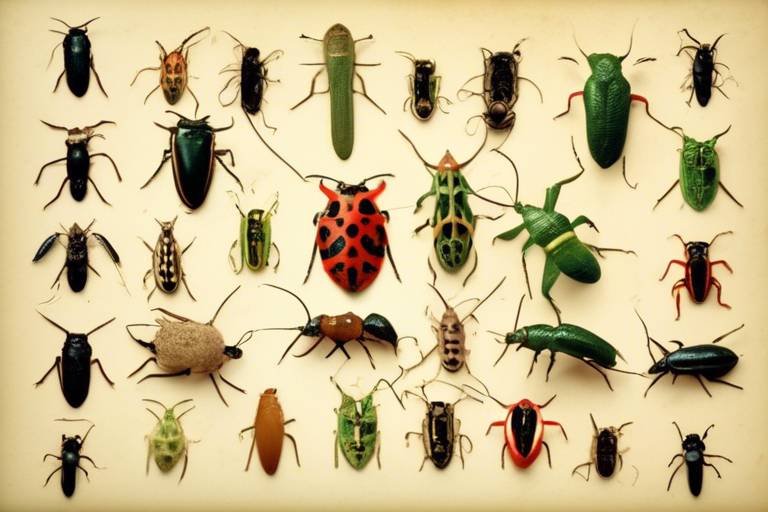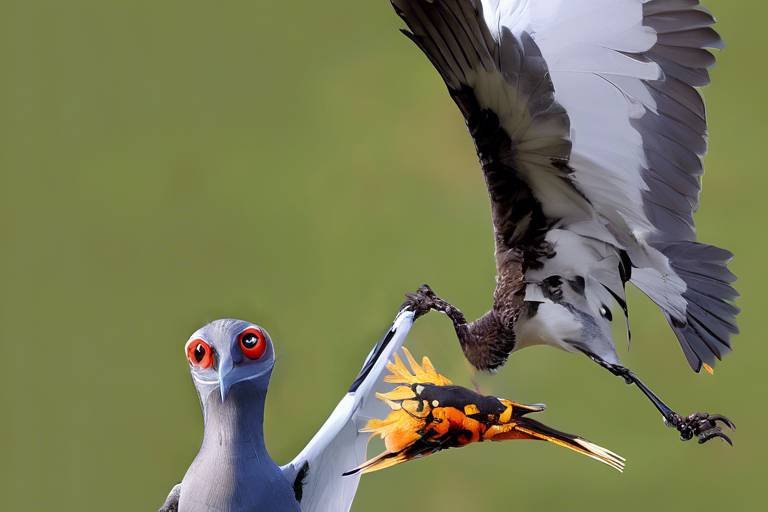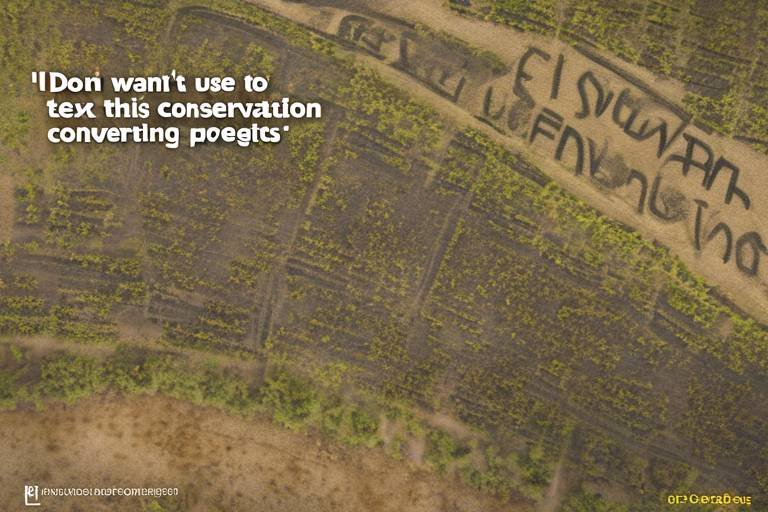Crucial Connections: Biodiversity’s Role in Pest Control
Biodiversity is often seen as a buzzword in environmental discussions, but its significance runs much deeper than surface-level appreciation. Imagine a complex web of life, where every thread, from the tiniest microbe to the largest predator, plays a vital role in maintaining balance. This intricate tapestry is not just beautiful; it is essential for our survival and particularly crucial for effective pest control in agricultural systems. In a world increasingly reliant on chemical solutions, understanding and leveraging the power of biodiversity can lead to healthier ecosystems and more sustainable farming practices.
When we talk about biodiversity, we refer to the variety of life forms on Earth, encompassing different species, genetic variations, and ecosystems. This diversity is not merely a luxury; it's a necessity. Without it, ecosystems become fragile and more susceptible to pests, diseases, and the ever-looming threat of climate change. For instance, a diverse range of crops can create a more resilient agricultural landscape, capable of withstanding pest infestations and reducing the need for harmful pesticides. It’s like having a diverse toolbox; each tool serves a unique purpose, and together they provide a robust solution to complex problems.
One of the most fascinating aspects of biodiversity is how it fosters natural pest control mechanisms. In a thriving ecosystem, different species interact in ways that can naturally suppress pest populations. For example, certain plants can attract beneficial insects that prey on pests, creating a self-regulating system. This not only minimizes the reliance on chemical pesticides but also promotes a healthier environment for both crops and consumers. Imagine walking through a field filled with various plants, each contributing to a natural balance, where pests are kept in check without the need for synthetic interventions. This is the promise of biodiversity in pest management.
Moreover, biodiversity is not limited to plants and insects; it extends to soil organisms as well. Healthy soil teems with life, from bacteria and fungi to earthworms and nematodes, all of which contribute to plant health and pest suppression. A diverse soil ecosystem enhances nutrient cycling and improves plant resistance to pests, creating a robust foundation for sustainable agriculture. Think of soil as a living entity, where every organism plays a role in nurturing crops and defending against pests. The more diverse the soil life, the healthier the plants, and the less vulnerable they are to infestations.
In conclusion, the role of biodiversity in pest control cannot be overstated. It is a critical component of agricultural sustainability, ecosystem health, and the balance of natural pest management systems. By fostering biodiversity, we not only enhance pest control but also ensure the longevity and resilience of our agricultural practices. As we continue to navigate the challenges posed by modern farming and climate change, embracing biodiversity may just be the key to a more sustainable future.
- What is biodiversity? Biodiversity refers to the variety of life forms on Earth, including different species, genetic variations, and ecosystems.
- How does biodiversity contribute to pest control? Biodiversity fosters natural pest control mechanisms by creating a balanced ecosystem where different species interact to suppress pest populations.
- Why is soil biodiversity important? Soil biodiversity supports healthy plant growth and pest resistance, enhancing nutrient cycling and promoting sustainable agricultural practices.
- What are some challenges to biodiversity in agriculture? Modern agricultural practices, such as monoculture and climate change, threaten biodiversity and can lead to increased pest problems.

The Importance of Biodiversity
Biodiversity is the intricate tapestry of life on Earth, encompassing the variety of species, ecosystems, and genetic diversity that exist within our planet. It is not just a buzzword; it is the backbone of healthy ecosystems and, by extension, our agricultural systems. Imagine a world where every crop you grow is at the mercy of pests and diseases, with no natural defenses in place. That's a world devoid of biodiversity. The importance of biodiversity cannot be overstated, as it provides the resilience needed to combat pests, diseases, and the ever-looming threat of climate change.
When we talk about resilience, we're referring to the ability of ecosystems to withstand disturbances and maintain their functionality. Biodiversity acts as a buffer, ensuring that when one species falters, others can step in to fill the gap. This is particularly crucial in agricultural settings, where monocultures make crops vulnerable to pest outbreaks. A diverse ecosystem, on the other hand, can effectively manage pest populations through a variety of natural mechanisms.
For instance, consider how different species interact within an ecosystem. Each organism, from the tiniest microbe in the soil to the largest predator, plays a role in maintaining balance. This balance is key for natural pest control. When biodiversity is high, the interactions among species create a web of control that reduces the need for chemical pesticides. Here’s how biodiversity contributes to pest control:
- Natural Predators: The presence of natural predators, such as birds and insects, can keep pest populations in check.
- Genetic Diversity: A variety of genetic traits within a species can lead to increased resistance against diseases.
- Habitat Complexity: Diverse plant life creates habitats that support beneficial organisms, enhancing pest control.
This intricate web of life not only supports pest management but also promotes overall ecosystem health. Healthy ecosystems are better equipped to provide essential services such as pollination, nutrient cycling, and soil formation, all of which are vital for sustainable agriculture. Thus, protecting biodiversity should be a priority for farmers and policymakers alike.
In summary, biodiversity is not merely an environmental concern; it is a crucial element for agricultural sustainability. By fostering diverse ecosystems, we can enhance natural pest control mechanisms, reduce the reliance on synthetic pesticides, and ultimately create a healthier planet. So, the next time you think about biodiversity, remember that it’s not just about saving the cute animals or beautiful plants; it’s about ensuring our food systems can thrive in the face of challenges.

Natural Pest Control Mechanisms
Understanding the intricate dance of life within ecosystems reveals the that work tirelessly to maintain balance. In nature, a web of interactions exists among various species, each playing a unique role in pest management. This interconnectedness not only helps in reducing pest populations but also minimizes the need for chemical interventions, paving the way for healthier agricultural practices. Imagine a well-orchestrated symphony where every instrument contributes to a harmonious outcome; this is what biodiversity achieves in pest control.
One of the most fascinating aspects of natural pest control is the role of predators and parasitoids. Predators, such as ladybugs, lacewings, and spiders, actively hunt down pests like aphids and caterpillars. Their presence in an ecosystem can lead to a significant reduction in pest populations, often making chemical pesticides unnecessary. On the other hand, parasitoids, which include certain wasps, take a more indirect approach. They lay their eggs inside or on the bodies of pest insects, leading to the eventual demise of the host. This method is not just effective; it’s a natural way to keep pest populations in check while promoting biodiversity.
To illustrate the effectiveness of these natural mechanisms, consider the following table showcasing some common agricultural pests and their natural enemies:
| Pest | Natural Predator | Type of Control |
|---|---|---|
| Aphids | Ladybugs | Predation |
| Tomato Hornworm | Braconid Wasps | Parasitism |
| Whiteflies | Lacewings | Predation |
| Leafhoppers | Predatory Mites | Predation |
Moreover, the relationship between plant diversity and pest resistance cannot be overlooked. When a variety of plant species coexist, they create habitats that support beneficial insects. These beneficial insects can disrupt pest life cycles, making it harder for pests to establish themselves in the first place. For example, planting flowering plants alongside crops can attract pollinators and natural enemies of pests, enhancing the overall resilience of the ecosystem.
In summary, the natural pest control mechanisms that arise from biodiversity are not just fascinating; they are essential for sustainable agriculture. By understanding and fostering these natural relationships, we can create a more balanced ecosystem that thrives without the heavy reliance on synthetic pesticides. It’s a win-win situation: healthier crops and a healthier planet!
- What are natural pest control mechanisms?
Natural pest control mechanisms refer to the interactions among various species in an ecosystem that help regulate pest populations without the need for chemical pesticides. - How do predators help in pest control?
Predators actively hunt and consume pest insects, significantly reducing their populations and minimizing the need for synthetic pest control methods. - What role do parasitoids play?
Parasitoids lay their eggs in or on pest insects, leading to the pest's eventual death, thus helping to keep pest numbers in check. - Why is plant diversity important for pest control?
Diverse plant species create habitats that support beneficial insects, disrupting pest life cycles and enhancing ecosystem resilience.

Predators and Parasitoids
When we think about pest control, it's essential to recognize the unsung heroes of our ecosystems: predators and parasitoids. These remarkable creatures are nature's way of keeping pest populations in check, ensuring that our agricultural landscapes remain healthy and vibrant. Imagine a world where pests run rampant, destroying crops and disrupting food chains. It’s a nightmare scenario, right? Thankfully, predators and parasitoids step in to prevent this chaos.
Predators are organisms that hunt and consume other organisms, while parasitoids are a unique group that lay their eggs on or in a host organism, ultimately leading to the host's demise. Together, they form a dynamic duo in the realm of pest management. For instance, consider the ladybug, a beloved garden inhabitant known for its voracious appetite for aphids. Just a few ladybugs can devour hundreds of aphids in a single day, showcasing how a small population of predators can significantly reduce pest numbers.
Parasitoids, on the other hand, take a more indirect approach. They often target pests that are already causing damage to crops. For example, certain wasps lay their eggs inside caterpillars. As the wasp larvae develop, they feed on the caterpillar, ultimately leading to its death. This method not only reduces the pest population but also prevents the use of chemical pesticides, which can harm beneficial insects and disrupt the ecosystem. By promoting these natural pest control agents, farmers can foster a healthier environment while maintaining crop yields.
Here’s a quick look at some effective predators and parasitoids:
| Type | Example Species | Pest Targeted |
|---|---|---|
| Predator | Ladybug | Aphids |
| Predator | Lacewing | Aphids, thrips |
| Parasitoid | Braconid Wasp | Caterpillars |
| Parasitoid | Ichneumon Wasp | Various pests |
By understanding the roles of these predators and parasitoids, we can appreciate their contribution to sustainable agriculture. Instead of relying solely on synthetic pesticides, integrating these natural allies into pest management strategies can lead to healthier ecosystems and more resilient crop systems. This approach not only protects our food supply but also enhances biodiversity, creating a win-win situation for both farmers and the environment.
In conclusion, the interplay between predators and parasitoids is a fascinating aspect of biodiversity that highlights the importance of natural pest control. By acknowledging and harnessing these relationships, we can pave the way for a more sustainable future in agriculture. So next time you spot a ladybug or a wasp, remember that these little creatures are doing big things to keep our ecosystems in balance!
- What are predators in pest control? Predators are organisms that hunt and eat other organisms, helping to control pest populations naturally.
- How do parasitoids work? Parasitoids lay their eggs in or on pest insects, leading to the eventual death of the host and reducing pest numbers.
- Can I encourage predators and parasitoids in my garden? Yes! Planting diverse flowers and avoiding pesticides can attract these beneficial insects.
- Why is it important to use natural pest control? Natural pest control methods reduce reliance on chemicals, promote biodiversity, and help maintain healthy ecosystems.

Examples of Effective Predators
When it comes to natural pest control, effective predators are the unsung heroes of our ecosystems. They not only help keep pest populations in check but also play a crucial role in maintaining the overall health of agricultural environments. Some of the most recognized predators include ladybugs, lacewings, and predatory mites. Each of these species has unique characteristics that make them particularly effective at managing pest populations.
For instance, ladybugs are often celebrated for their voracious appetite for aphids, which are notorious pests that can devastate crops. A single ladybug can consume up to 50 aphids a day, making them a powerful ally for farmers. Lacewings, on the other hand, are known for their larvae, which are sometimes referred to as "aphid lions" due to their aggressive predation on aphids and other soft-bodied insects. This predatory behavior not only reduces pest numbers but also contributes to a healthier crop yield.
Moreover, predatory mites play an essential role in controlling populations of spider mites, another common agricultural pest. By introducing these beneficial predators into crop systems, farmers can create a more balanced ecosystem that minimizes the need for chemical pesticides. This approach not only protects the environment but also enhances the quality of the produce.
It's fascinating to note that the presence of these predators can lead to a phenomenon known as trophic cascades. This occurs when the removal or addition of one species impacts the entire food web. For example, if ladybugs are introduced into a field, they can significantly reduce aphid populations. This reduction allows plants to thrive, which in turn supports a diverse range of other species, creating a robust ecosystem.
To sum it up, the integration of effective predators like ladybugs, lacewings, and predatory mites into agricultural practices is not just beneficial; it's essential for sustainable farming. By embracing these natural allies, we can reduce our dependency on synthetic pesticides and foster a more resilient agricultural landscape.
- What are the benefits of using natural predators for pest control?
Natural predators help maintain ecological balance, reduce the need for chemical pesticides, and promote healthier crop yields. - How can I attract effective predators to my garden?
Planting a variety of flowering plants, providing shelter, and avoiding pesticides can help attract beneficial insects like ladybugs and lacewings. - Are there any risks associated with introducing predators into an ecosystem?
While generally beneficial, it’s important to ensure that introduced species do not become invasive and disrupt local ecosystems.

Parasitoids as Biological Control Agents
Parasitoids are fascinating creatures that play a critical role in the world of pest management. Unlike typical predators, which consume their prey, parasitoids have a unique lifecycle that involves laying their eggs inside or on the bodies of other insects. This process ultimately leads to the host insect's demise, making them incredibly effective biological control agents. Imagine a tiny wasp laying its eggs in a caterpillar; as the larvae hatch, they consume the caterpillar from the inside out. It's a gruesome but effective method of controlling pest populations!
These remarkable organisms help maintain the balance of ecosystems by naturally regulating pest populations that would otherwise explode in numbers. For instance, certain species of wasps are known to target aphids, a common pest that can devastate crops. By introducing these parasitoids into agricultural settings, farmers can significantly reduce aphid populations without resorting to chemical pesticides. This not only promotes a healthier environment but also supports sustainable farming practices.
But how do parasitoids fit into the larger picture of biodiversity? They are often part of a complex web of interactions within ecosystems. The presence of diverse parasitoid species can lead to a more stable and resilient ecosystem. When different parasitoids target various pests, they create a natural balance that helps prevent any one species from dominating. This diversity is essential, as it ensures that pest control remains effective even when environmental conditions change.
To illustrate the effectiveness of parasitoids in pest control, consider the following table that highlights some common parasitoid species and their target pests:
| Parasitoid Species | Target Pest | Effectiveness |
|---|---|---|
| Trichogramma spp. | Various moth eggs | Highly effective |
| Aphelinus mali | Woolly apple aphid | Effective |
| Microplitis croceipes | Armyworm larvae | Very effective |
Incorporating parasitoids into pest management strategies not only reduces the need for synthetic pesticides but also enhances the overall health of the ecosystem. By fostering an environment where these beneficial insects can thrive, farmers can create a more sustainable agricultural system that supports both biodiversity and crop productivity. So the next time you see a wasp buzzing around, remember that it might just be a tiny hero in the battle against pests!
- What are parasitoids? Parasitoids are insects that lay their eggs inside or on other insects, eventually leading to the host's death.
- How do parasitoids help in pest control? They naturally regulate pest populations by targeting specific pests, reducing the need for chemical pesticides.
- Can parasitoids be used in organic farming? Yes, many organic farmers use parasitoids as a natural method of pest control.
- Are all parasitoids harmful to beneficial insects? No, many parasitoids specifically target harmful pests without affecting beneficial insects.

Plant Diversity and Pest Resistance
Plant diversity is not just a pretty sight; it plays a critical role in enhancing pest resistance in agricultural systems. When we cultivate a variety of plant species, we create a mosaic of habitats that can support a wide range of beneficial insects and organisms. These allies in the ecosystem can disrupt pest life cycles and help keep harmful populations in check. Think of it like a well-orchestrated symphony where each instrument contributes to the overall harmony; every plant species has its unique role that contributes to pest management and ecosystem health.
One of the key benefits of plant diversity is that it can attract natural predators and parasitoids that prey on pests. For instance, flowering plants can provide nectar and pollen, which support beneficial insects like ladybugs and lacewings. These insects, in turn, help to keep pest populations under control. Moreover, diverse plantings can create microhabitats that offer shelter and resources for these beneficial species, increasing their effectiveness in managing pests naturally.
Another significant aspect of plant diversity is its ability to disrupt pest life cycles. When crops are planted in monocultures, pests can easily find their preferred food source, leading to rapid population growth. However, when different plant species are interspersed, pests may struggle to locate their hosts. This disruption can lead to lower infestation rates and reduce the need for chemical interventions. In essence, a diverse plant community acts as a natural barrier against pest invasions.
To illustrate the benefits of plant diversity, consider the following table that summarizes the advantages of incorporating diverse plant species into agricultural settings:
| Benefit | Description |
|---|---|
| Natural Pest Control | Diverse plants attract beneficial insects that prey on pests. |
| Pest Life Cycle Disruption | Variety in plant species makes it harder for pests to locate their food. |
| Soil Health Improvement | Diverse root systems enhance soil structure and nutrient availability. |
| Resilience to Diseases | A mix of plant species can reduce the spread of plant-specific diseases. |
In conclusion, embracing plant diversity is a strategic approach to building pest resistance in agricultural practices. By cultivating a variety of crops, farmers can create a more resilient ecosystem that not only supports pest management but also enhances overall soil health and productivity. So, the next time you think about planting, remember that diversity isn't just a buzzword—it's a vital ingredient for sustainable agriculture.
- Why is biodiversity important for pest control?
Biodiversity helps maintain ecosystem balance, providing natural mechanisms to control pest populations without relying heavily on chemical pesticides.
- How does plant diversity affect pest resistance?
Diverse plantings disrupt pest life cycles, attract beneficial insects, and create habitats that support natural pest control.
- What are some examples of beneficial insects?
Ladybugs, lacewings, and certain wasps are effective predators and parasitoids that help manage pest populations.
- Can increasing plant diversity improve soil health?
Yes, diverse root systems enhance soil structure and nutrient cycling, contributing to overall soil health and crop resilience.

The Role of Soil Biodiversity
Soil biodiversity is not just a buzzword; it is a fundamental component of healthy ecosystems and sustainable agriculture. The diversity of organisms that inhabit the soil—from bacteria and fungi to insects and earthworms—plays a crucial role in maintaining plant health and enhancing pest resistance. When we talk about soil biodiversity, we're referring to the variety of life forms that exist in the soil and their interactions, which create a complex web of life that supports agricultural productivity.
One of the most significant benefits of soil biodiversity is its ability to suppress pest populations naturally. Healthy soils are teeming with beneficial organisms that can outcompete or prey on harmful pests. For instance, certain bacteria and fungi can produce natural toxins that deter pest insects, while predatory nematodes and insects can help keep pest populations in check. This natural pest control reduces the need for synthetic pesticides, which can be harmful to both the environment and human health.
Moreover, soil biodiversity contributes to nutrient cycling, which is vital for plant growth. Different organisms play unique roles in breaking down organic matter, releasing essential nutrients that plants need to thrive. For example, mycorrhizal fungi form symbiotic relationships with plant roots, enhancing nutrient uptake and improving plant resilience against pests and diseases. The more diverse the soil community, the more robust these processes become, leading to healthier crops that can withstand pest pressures.
It's also important to recognize that soil health is directly linked to crop yields. A diverse soil ecosystem can improve water retention, soil structure, and nutrient availability, all of which contribute to higher productivity. When farmers prioritize soil biodiversity through practices such as cover cropping, crop rotation, and reduced tillage, they not only enhance soil health but also create a more resilient agricultural system capable of withstanding the challenges posed by pests and climate change.
To illustrate the impact of soil biodiversity on agricultural productivity, consider the following table:
| Soil Organism | Role in Pest Control | Impact on Crop Yields |
|---|---|---|
| Mycorrhizal Fungi | Enhances nutrient uptake; improves plant resilience | Increases yields by up to 20% |
| Predatory Nematodes | Prey on pest larvae | Reduces pest populations, enhancing crop health |
| Beneficial Bacteria | Suppress pathogens; promote nutrient cycling | Improves soil fertility, leading to higher yields |
In summary, the role of soil biodiversity in pest control and agricultural sustainability cannot be overstated. By fostering a diverse soil ecosystem, farmers can create a natural defense against pests while simultaneously enhancing crop yields and promoting overall soil health. As we face increasing challenges from pests and climate change, embracing soil biodiversity is not just beneficial; it is essential for the future of agriculture.
What is soil biodiversity?
Soil biodiversity refers to the variety of living organisms in the soil, including bacteria, fungi, insects, and other microorganisms that contribute to ecosystem health and agricultural productivity.
How does soil biodiversity affect pest control?
Soil biodiversity enhances natural pest control by supporting beneficial organisms that can suppress pest populations, reducing the reliance on chemical pesticides.
What practices can enhance soil biodiversity?
Practices such as cover cropping, crop rotation, reduced tillage, and organic farming can help enhance soil biodiversity and improve overall soil health.
Why is soil health important for agriculture?
Healthy soil supports plant growth, improves crop yields, and enhances resilience against pests and diseases, making it crucial for sustainable agricultural practices.

Microbial Interactions in Soil
When we think about soil, we often picture a lifeless, barren substance that simply supports plant life. However, soil is teeming with life, primarily in the form of microorganisms. These tiny organisms, including bacteria, fungi, and protozoa, play a vital role in the ecosystem, particularly in nutrient cycling and pest suppression. Imagine a bustling city where each microbe has a specific job, working together to maintain the health of the environment. This intricate web of interactions not only supports plant growth but also helps in managing pest populations naturally.
One of the key functions of soil microbes is their involvement in nutrient cycling. They break down organic matter, releasing essential nutrients that plants need to thrive. For instance, bacteria decompose dead plant and animal material, converting it into forms that plants can easily absorb. This process enriches the soil, making it more fertile and less susceptible to pest infestations. Additionally, certain fungi form symbiotic relationships with plant roots, enhancing nutrient uptake and improving plant resilience against pests. It's like having a personal trainer for plants, helping them grow stronger and more capable of fighting off invaders.
Moreover, microbial interactions can actively suppress pests. Certain bacteria and fungi produce natural compounds that deter harmful insects and pathogens. For example, some strains of Bacillus thuringiensis (Bt) are used as a biological pesticide. These bacteria produce toxins that are harmful to specific insect pests but harmless to humans and beneficial insects. By fostering a diverse microbial community in the soil, farmers can enhance this natural pest control, reducing the need for chemical pesticides and promoting a healthier ecosystem.
To grasp how these microbial interactions function, consider the following table that summarizes the roles of different microorganisms in soil health:
| Microorganism Type | Role in Soil Health | Impact on Pest Control |
|---|---|---|
| Bacteria | Decompose organic matter, fix nitrogen | Produce toxins that deter pests |
| Fungi | Form symbiotic relationships with plants | Enhance plant resilience against pests |
| Protozoa | Regulate bacterial populations, promote nutrient cycling | Indirectly suppress pests by promoting healthy plants |
In conclusion, the interactions between soil microbes are essential for maintaining healthy ecosystems. They not only support plant growth through nutrient cycling but also play a significant role in managing pest populations naturally. By understanding and enhancing these microbial communities, we can promote more sustainable agricultural practices and reduce our reliance on synthetic pesticides. So, the next time you dig your hands into the soil, remember that it's not just dirt—it's a bustling metropolis of life working tirelessly to keep our plants healthy and our ecosystems balanced.
- What are the main types of microorganisms found in soil? The main types include bacteria, fungi, and protozoa, each playing unique roles in soil health and pest control.
- How do microorganisms contribute to pest control? They produce natural compounds that can deter pests and enhance plant health, making them more resilient against infestations.
- Can I improve microbial activity in my garden? Yes! Practices such as adding organic matter, reducing chemical inputs, and maintaining soil moisture can enhance microbial diversity and activity.

Soil Health and Crop Yields
Soil health is the backbone of agricultural productivity, directly influencing crop yields and resilience against pests. Healthy soil is teeming with life, from tiny microbes to larger organisms, all playing a role in creating a vibrant ecosystem that supports plant growth. When soil is rich in biodiversity, it improves nutrient cycling, enhances water retention, and promotes root development, which are all crucial for plants to thrive. Imagine soil as a bustling city; the more diverse the population, the more services and functions it can provide. Just like a city with a variety of businesses and services can support its residents better, diverse soil organisms can support plants more effectively.
Research has shown that healthy soils are often linked to higher crop yields. For instance, fields with a rich microbial community can yield up to 30% more than those with depleted soil health. This is because diverse soil life helps break down organic matter, releasing essential nutrients that plants need to grow. Furthermore, these organisms can form symbiotic relationships with plant roots, enhancing nutrient absorption. Here’s a quick breakdown of how soil health contributes to crop yields:
- Nutrient Availability: Healthy soils provide a steady supply of nutrients.
- Water Retention: Well-structured soils retain moisture, reducing the need for irrigation.
- Pest Suppression: Diverse soil organisms can naturally suppress pest populations.
Moreover, a focus on improving soil health can lead to sustainable agricultural practices that benefit both farmers and the environment. By adopting practices such as crop rotation, cover cropping, and reduced tillage, farmers can foster soil biodiversity. These practices not only enhance soil structure but also create a habitat for beneficial organisms that contribute to pest management and overall ecosystem health. In essence, investing in soil health is akin to investing in a solid foundation for a house; without it, everything else is at risk.
In conclusion, the connection between soil health and crop yields cannot be overstated. By prioritizing biodiversity and implementing sustainable practices, we can ensure that our soils remain productive for generations to come. This holistic approach not only boosts agricultural output but also promotes a balanced ecosystem, ultimately leading to greater food security and environmental sustainability.
- What is soil health? Soil health refers to the condition of soil in relation to its ability to function as a living ecosystem that sustains plants, animals, and humans.
- How does soil biodiversity affect crop yields? Higher soil biodiversity enhances nutrient cycling, water retention, and pest suppression, leading to improved crop yields.
- What practices can improve soil health? Practices such as crop rotation, cover cropping, and reduced tillage can significantly enhance soil health and biodiversity.
- Why is pest suppression important in agriculture? Effective pest suppression reduces the reliance on synthetic pesticides, promoting healthier crops and ecosystems.

Challenges to Biodiversity in Agriculture
Modern agricultural practices are often at odds with the very essence of biodiversity, leading to a cascade of challenges that threaten the delicate balance of ecosystems. One of the most significant culprits is the widespread adoption of monoculture farming, where a single crop species is cultivated over large areas. This practice not only reduces the variety of plants but also diminishes the habitats available for beneficial organisms. The result? A more vulnerable agricultural landscape, ripe for pest infestations and disease outbreaks.
Moreover, the relentless use of chemical pesticides and fertilizers has further compounded the issue. These substances, while effective in the short term, can lead to long-lasting damage to soil health and disrupt the natural predator-prey relationships that are essential for pest control. As beneficial insects and microorganisms are wiped out, the reliance on synthetic chemicals increases, creating a vicious cycle that is hard to break.
Another pressing challenge is climate change, which poses a significant threat to biodiversity in agriculture. Changing weather patterns affect the timing of plant growth and pest life cycles, leading to mismatches in natural pest control mechanisms. For instance, if temperatures rise earlier in the spring, pests may emerge before their natural predators, resulting in unchecked populations. This shift not only impacts crop yields but also forces farmers to adapt their pest management strategies continually.
To further illustrate the challenges, consider the following table that outlines the key threats to biodiversity in agricultural systems:
| Challenge | Description |
|---|---|
| Monoculture | Reduces plant diversity, increasing susceptibility to pests and diseases. |
| Pesticide Use | Harms beneficial organisms, leading to a higher reliance on chemicals for pest control. |
| Climate Change | Alters pest life cycles and plant growth patterns, disrupting natural pest control. |
As we navigate these challenges, it’s essential to recognize that promoting biodiversity is not just beneficial; it is necessary for sustainable agriculture. Farmers and policymakers must work together to implement practices that support diverse ecosystems. This includes crop rotation, intercropping, and organic farming methods that prioritize soil health and ecological balance. By fostering an environment where biodiversity can thrive, we can create resilient agricultural systems that are better equipped to handle the pressures of pests, diseases, and climate change.
- What is biodiversity and why is it important for agriculture?
Biodiversity refers to the variety of life in a particular habitat or ecosystem. In agriculture, it is crucial as it enhances resilience against pests and diseases, improves soil health, and supports sustainable farming practices. - How does monoculture farming impact biodiversity?
Monoculture farming reduces the variety of crops grown in an area, which can lead to increased vulnerability to pests and diseases, as well as a decline in beneficial organisms. - What are some sustainable practices to promote biodiversity in agriculture?
Practices such as crop rotation, intercropping, organic farming, and the use of cover crops can enhance biodiversity and improve ecosystem health. - How does climate change affect pest control in agriculture?
Climate change can alter the timing of pest life cycles and plant growth, leading to mismatches in natural pest control and potentially increased pest populations.

Monoculture and Its Impacts
Monoculture, the agricultural practice of growing a single crop over a wide area for consecutive seasons, might seem like an efficient way to maximize yields. However, this approach can have dire consequences for biodiversity and pest management. When farmers focus solely on one type of crop, they inadvertently create an environment that is ripe for pest infestations. Why? Because monocultures lack the diversity that naturally regulates pest populations.
In a diverse ecosystem, various species coexist, each playing a role in maintaining balance. Predators, parasitoids, and beneficial insects thrive in environments where multiple plant species are present. These organisms contribute to natural pest control, keeping pest populations in check. In contrast, monocultures provide a buffet for pests, allowing them to proliferate unchecked. As a result, farmers often resort to chemical pesticides, which can harm beneficial insects and further disrupt the ecosystem.
Moreover, monoculture farming can lead to the depletion of soil nutrients. Different plants have varied nutrient requirements and contribute to soil health in unique ways. When the same crop is planted repeatedly, the soil becomes exhausted, leading to reduced crop resilience against pests and diseases. This creates a vicious cycle where farmers are forced to use more fertilizers and pesticides to compensate for the declining health of their crops.
To illustrate the impacts of monoculture, consider the following table:
| Aspect | Monoculture | Diverse Cropping Systems |
|---|---|---|
| Pest Resistance | Low | High |
| Soil Health | Degraded | Enhanced |
| Need for Pesticides | High | Low |
| Crop Yield Stability | Vulnerable | Resilient |
Ultimately, the reliance on monoculture not only jeopardizes the health of the ecosystem but also threatens the long-term viability of agricultural practices. Farmers looking to achieve sustainable growth should consider integrating diverse cropping systems. This approach not only enhances biodiversity but also fosters a more resilient agricultural landscape. By embracing diversity in their fields, farmers can reduce the reliance on harmful pesticides, improve soil health, and create a balanced ecosystem that supports both crops and beneficial organisms.
- What is monoculture? Monoculture is the agricultural practice of cultivating a single crop over a wide area for multiple seasons.
- How does monoculture affect pest populations? Monoculture creates an environment that allows pests to thrive, leading to increased infestations and a greater reliance on chemical pesticides.
- What are the benefits of diverse cropping systems? Diverse cropping systems enhance pest resistance, improve soil health, and reduce the need for synthetic pesticides, promoting a more sustainable agricultural practice.
- Can monoculture lead to soil degradation? Yes, repeated planting of the same crop can deplete soil nutrients, leading to degraded soil health and reduced crop resilience.

Climate Change Effects
Climate change is more than just a buzzword; it’s a reality that’s reshaping our planet's ecosystems and, in turn, affecting biodiversity and pest control. As temperatures rise and weather patterns shift, the delicate balance that exists within ecosystems is being disrupted. This disruption can have profound effects on the relationships between species, including those that are vital for pest management.
For instance, many insects and other pests are highly sensitive to temperature changes. As the climate warms, pests may find themselves thriving in areas that were previously inhospitable. This can lead to an increase in pest populations, putting additional stress on crops and natural ecosystems. In fact, studies have shown that some pests can reproduce more rapidly as temperatures rise, leading to explosive population growth. This situation creates a vicious cycle where the increased pest populations further threaten biodiversity.
Moreover, climate change can alter the distribution of both pests and their natural enemies. Predators and parasitoids, which are crucial for keeping pest populations in check, may not be able to adapt quickly enough to the changing conditions. For example, if a certain predator species can only thrive in specific temperature ranges, a rise in global temperatures could push them out of their optimal habitat, leaving pests unchecked. This imbalance can lead to a significant increase in agricultural losses.
Another critical aspect to consider is the impact of extreme weather events, such as droughts and floods. These events can destroy habitats, reduce food sources, and disrupt the life cycles of both pests and their natural enemies. For instance, a severe drought may diminish the populations of beneficial insects, while simultaneously allowing pest species to flourish due to decreased competition. This scenario highlights the interconnectedness of climate systems and biodiversity.
In light of these challenges, it’s essential for farmers and policymakers to adapt their pest management strategies. Emphasizing biodiversity in agricultural practices can help build resilience against the impacts of climate change. By fostering a diverse ecosystem, we can create a buffer against pest outbreaks and enhance the effectiveness of natural pest control mechanisms.
Here are a few strategies that can be adopted to mitigate the effects of climate change on biodiversity and pest control:
- Diverse cropping systems: Incorporating a variety of crops can disrupt pest life cycles and enhance the presence of beneficial organisms.
- Habitat restoration: Restoring natural habitats around agricultural fields can provide refuge for natural enemies of pests.
- Integrated Pest Management (IPM): Utilizing a combination of biological, cultural, and mechanical practices can help manage pest populations sustainably.
In conclusion, the effects of climate change on biodiversity and pest control are profound and complex. As we face these challenges, it’s crucial to prioritize biodiversity in our agricultural practices. By doing so, we can not only combat pest issues more effectively but also contribute to the health of our ecosystems.
- How does climate change affect pest populations?
Climate change can lead to increased temperatures and altered weather patterns, which can create favorable conditions for pests to thrive and reproduce rapidly. - What role do natural predators play in pest control?
Natural predators help keep pest populations in check by preying on them, thereby reducing the need for chemical pesticides. - Can biodiversity help mitigate the effects of climate change?
Yes, a diverse ecosystem can enhance resilience against climate change impacts, making it easier to manage pests and maintain agricultural productivity.
Frequently Asked Questions
- What is biodiversity and why is it important for pest control?
Biodiversity refers to the variety of life forms within a given ecosystem. It's crucial for pest control because a diverse ecosystem can naturally regulate pest populations, reducing the need for chemical pesticides. This balance helps maintain agricultural sustainability and ecosystem health.
- How do predators and parasitoids contribute to pest control?
Predators like ladybugs and lacewings actively hunt and consume pests, while parasitoids, such as certain wasps, lay their eggs inside pest insects. This natural predation and parasitism help keep pest populations in check, allowing for healthier crops without relying heavily on synthetic chemicals.
- Can planting diverse crops help with pest resistance?
Absolutely! Planting a variety of crops creates habitats for beneficial insects and disrupts pest life cycles. This diversity not only enhances pest resistance but also promotes a balanced ecosystem, making crops less vulnerable to infestations.
- What role does soil biodiversity play in agriculture?
Soil biodiversity is vital for plant health and pest resistance. A diverse soil ecosystem supports various organisms that can naturally suppress pest populations, leading to improved soil health and enhanced crop yields. Healthy soils contribute significantly to sustainable agricultural practices.
- What challenges does modern agriculture face regarding biodiversity?
Modern agricultural practices, such as monoculture, threaten biodiversity by creating environments that are more susceptible to pests and diseases. Additionally, climate change poses significant challenges, altering species interactions and requiring adaptive pest control strategies to maintain biodiversity.



















